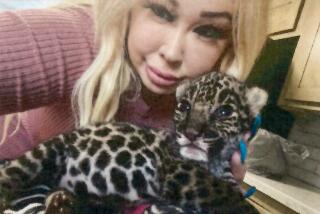Meerly beloved
MORONGO VALLEY, CALIF. — Over the years, scientific films and National Geographic specials have inspired visitors to a small, out-of-the-way meerkat sanctuary here. One of the draws was a resident meerkat who served as the model for Timon in “The Lion King.”
But that’s nothing compared to the surge of interest since Animal Planet’s hit series “Meerkat Manor” made stars of the Whisker family, the cooperative, contentious, highly dramatic animals that race through their days on the Kalahari Desert at fast-forward speed, following the lead of their matriarch, Flower, an expert in realpolitik and breeding. Cartoonishly digging, play fighting, scent marking and war hopping, the Whiskers wind up even their toughest days in a group hug.
As fans made “Meerkat Manor’s” Season 2 finale Animal Planet’s most watched prime-time show, television crews, newspaper and magazine reporters and curious individuals have worn ruts in the three dirt roads leading to the Fellow Earthlings’ Wildlife Center. The center has a laundry basket full of cards, photos and drawings, not to mention gifts and handmade meerkat-themed curios, including a meerkat quilt.
With Season 3 launching on Friday, and a feature film planned for next year, the wait for ordinary visitors to see the seven meerkats inside their spacious enclosures now runs about six months, said founder Pam Bennett-Wallberg.
The nonprofit center has partnered with Animal Planet in a contest ending Aug. 30 that features a visit to the center as the grand prize. Bennett-Wallberg also serves as a publicity spokeswoman for the series.
For a few hours, visitors (who usually pay a $100 adoption fee) can watch the meerkats at their daily routine: sunning, romping around, mutual grooming and hugging at sunset. They can enter the enclosures and, provided with thick gloves, feed the animals.
Like many celebrities, the meerkats look much smaller in real life. Relatives to the mongoose and ferrets, they’re about 12 inches tall, with pups about 2 inches.
The wild Kalahari branch of meerkats, scratching for survival in the bush, probably wouldn’t recognize its long-lost relatives rescued from zoos when they became sickly or elderly. While they still stand straight up and sound an alarm when a strange helicopter passes overhead, these mammals live in relative luxury. They don’t have to dig five feet underground to sleep in burrows; they lounge in mini club chairs. They don’t need to fight for territory; they live in pairs and threes in separate enclosures.
Their toys are stuffed with live worms. Their scorpions are served with stingers removed.
“We believe in enrichment and engagement,” Bennett-Wallberg said.
Thomas P. Flower, field project manager of the Kalahari Meerkat Project in the Kuruman River Reserve where the Whiskers live, said even though he regards the animals through a scientific, rather than a dramatic lens, he’s seen both “lovely” and “shocking” behaviors in the wild meerkats. After a fight between two groups, he said a small pup got left behind. “One went back and picked up the pup from the melee. It looked like heroism. But it benefits the group. To the group, they are little bundles of gold.”
He saw two groups living on the periphery of the reserve line up and face each other before a mutual attack. “They dashed into each other, grabbing throats and raging.
“I’ve also seen them be pretty dumb, falling out of bushes.”
Animal Planet’s ads for Season 3 emphasize their strong personalities, dramatized on the show through soap opera-style narration and editing of extensive footage. A black-and-white print ad pictures the animals in a “Sopranos”-like pose above a red-lettered title: “The Family Is Back.” Instead of a gun, a meerkat on alert stands in for the letter I.
One of an upcoming series of spots focuses on individual members of the Whiskers family. Mozart, Flower’s reckless daughter, is pictured with her thoughts printed in the background: “My mother hates my boyfriend. We’ve moved 37 times in the last year. And my uncle may be my father.”
But even with the growth of meerkat mania, Bennett-Wallberg decided to keep the center the way it’s been for 20 years: an exclusive private reserve, with by-appointment-only visits for individuals or very small groups.
That’s what the meerkats like, she said. “If they didn’t love visitors,” she said, “you wouldn’t be here.”
--
--
Begin test of infobox
Why do they act that way?
Questions for meerkat specialist Tom Flower.
Q: Why do meerkats help each other?
A: It’s a result of living in an extreme desert environment. If you’re on your own, you starve or get eaten. People are captivated by their cooperative behavior because it seems individuals help others without any benefit to themselves. We’ve found benefits.
Q: Were the Whiskers really “sad” when Blossom the pup was lost and killed by a goshawk?
A: I don’t think so. It’s a really common thing to happen to meerkats. To be honest, they don’t notice when pups get [picked off by a predator].
Q: Why does Flower keep evicting her daughter Mozart from the group?
A: Dominant females monopolize all the breeding. They stop everyone else from breeding by beating them up. They also steal all their daughters’ food to stop them from breeding.
Dominant females also preemptively evict them when they’re not pregnant. If they’re stressed, they can’t conceive. It will also cause them to abort.
Q: Why bother getting pregnant when the outlook is so bleak?
A: It seems the reason for that is, if your babies do live, the benefits are incredibly high. When a dominant female dies, there’s a big shift among the daughters. One will rise to the top and take dominance. Though most females will never become the dominant female, their best bet is to try their best. Everything is riding on being a dominant. Clearly a female should spend her life to become that.
Q: How did Shakespeare die?
A: We just weren’t there when Shakespeare finally went. We don’t know 100%.
--
More to Read
Sign up for The Wild
We’ll help you find the best places to hike, bike and run, as well as the perfect silent spots for meditation and yoga.
You may occasionally receive promotional content from the Los Angeles Times.






